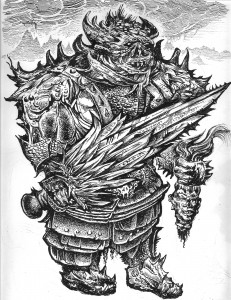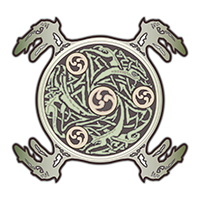The term “Behemoth” is derived from the Bible and comes from the Book of Job. It refers to a great beast that lay under the feet of God. It was used as an example of the force and power of God in controlling the beasts of the earth and the wild forces of the seas then believed by primitive Man to hide such untamed mythological forces. Leviathan is said to be the mortal enemy of Behemoth, and the two are said to battle at the end of days when God would rise up to destroy them both. As such, this mystical tale is a religious myth and metaphor of the transcendental forces of Nature and yet the power of the Creator over their defiant wills.
In the Phantammeron novels I am very interested in the power of these primitive references as described in the ancient literature. Such descriptions were designed to instill fear and wonder in the reader. I have tried to use these beasts and their conflicts as inspiration for myths found in my own mythopoeia.
In the world of ancient Anatar that appears in later books of the Phantammeron, Behemoths are summoned forth to destroy the world and battle the Primordial Ones. They are vague references to the various servants of the Limitless Void that were birthed in the first creation of the world. They were created with the aid of the evil twins, the Emptiness and Nothingness, that appear in Book One of the Phantammeron. A later child named Agapor summons the Behemoths again in Book One as a means to enforce his power over the Dreaming Seas. Many of the Behemoths are then destroyed by the seas, much like in the Biblical references.
The spirit and might of the Behemoth will rise again in the world of Anatar in the wars with the giants called the Skatha. In that story the Behemoth appears again as a massive titan of evil, a symbol of the powers of the Limitless Void their summoner and the darker forces set to pervert the forces of good in the world, sent to destroy all things made of flesh and of matter.
In later books on the battlefields of Anatar, one of these creatures wields a massive sword called Ginnikar, using it to destroy the leaders of the giants in Anatar. This “generation blade” used by the Behemoth is first forged by Govannon the Dwarf, slave of the giants, as a weapon of vengeance in the world to be used against his enslaver. Forged from the wild, white, wicked flame of Monadas, the sword carries forth both his love for Fey-Ama and his vengeance upon those who had taken her life. The story is a twisted plot, one of many that in later books still remain unfinished, yet which have been known to me in some form for many years. The tragic tale ends with the sword falling into the hands of the Behemoth, who then uses it unknowingly to destroy the Skatha, his ancient foe, in the mists of that new world’s first fallen age.
After the fall of the age of giants, it is the destiny of one of my many tragic heroes in that world, Fey-Hannon (a later Child of Shining), to rise up to slay the Lord Behemoth, saving the world from utter obliteration. The regenerating sword is then lost for all time in the underworld of Adda. But it served its purpose, drawing the blood of the Fey and the Children of Shining, as well as fulfilling its darker vengeance against the giants; a motivation plotted long before under the darker designs of Govannon.
Yet, in the bigger scheme of things, it turns out the life of the Behemoth in that ancient world and the savage and bloody sword he wielded were but tools to help fulfill the will of the Shadow Serpent, Ramaratha, and the curse of the silver bowl – the Argal-Pyr which he had long sought. Its the Sacred Waters contained therein, waters ripped away from Twilight Woods of Phantaia long before, that would rise up in the plot over and over to enact justice upon all the creatures of this world, including Ramaratha and his Behemoth, doing so many times in the books until the day the Pyr should either be destroyed or returned to the Sacred Pool of Eternity from which its waters were born.
– the Author




